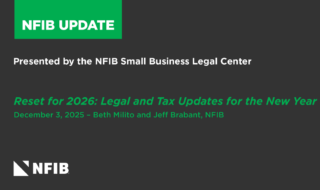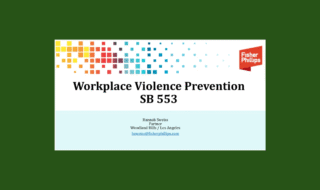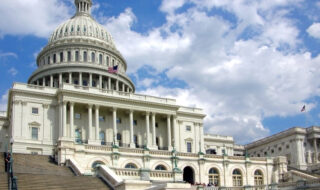NEW NFIB SURVEY: Small Business Optimism Rises
NEW NFIB SURVEY: Small Business Optimism Rises
August 12, 2025
Main Street Business Owners Report Improving Conditions
WASHINGTON, D.C. (August 12, 2025) – The NFIB Small Business Optimism Index rose 1.7 points in July to 100.3, slightly above the 52-year average of 98. Contributing most to the rise in the Optimism Index were respondents reporting better business conditions and reporting that it is a good time to expand. In contrast to the Optimism Index, the Uncertainty Index increased by eight points from June to 97. Twenty-one percent of small business owners reported labor quality as their single most important problem, up five points from June and ranking as the top problem.
“Optimism rose slightly in July with owners reporting more positive expectations on business conditions and expansion opportunities,” said NFIB Chief Economist Bill Dunkelberg. “While uncertainty is still high, the next six months will hopefully offer business owners more clarity, especially as owners see the results of Congress making the 20% Small Business Deduction permanent and the final shape of trade policy. Meanwhile, labor quality has become the top issue on Main Street again.”
Key findings include:
- In July, there was a notable improvement in overall business health. When asked to rate the overall health of their business, 13% reported excellent (up five points), and 52% reported good (up three points). Thirty-one percent reported the health of their business was fair (down four points), and 4% reported poor (down three points).
- The percent of small business owners reporting poor sales as their top business problem rose one point to 11%. This is the highest level of poor sales since February 2021.
- The net percent of owners expecting better business conditions rose 14 points from June to a net 36% (seasonally adjusted). This reading is comfortably above the historical average.
- In July, 16% (seasonally adjusted) reported that it is a good time to expand their business, up five points from June.
- Eleven percent of owners reported that inflation was their single most important problem in operating their business, unchanged from June’s lowest reading since September 2021.
- The net percent of owners expecting higher real sales volumes fell one point from June to a net 6% (seasonally adjusted). Though expected real sales are higher than actual sales, the current reading is also comfortably below the 52-year average.
- Twenty-two percent (seasonally adjusted) plan capital outlays in the next six months, up one point from June, but seven points below the historical average of 29%.
As reported in NFIB’s monthly jobs report, a seasonally adjusted 33% of all small business owners reported job openings they could not fill in July, down three points from June and the lowest level since December 2020, though still well above its monthly historical average of 25%. Of the 57% of owners hiring or trying to hire in July, 84% reported few or no qualified applicants for the positions they were trying to fill. A seasonally adjusted net 14% of owners plan to create new jobs in the next three months, up one point from June.
The percent of business owners reporting labor costs as the single most important problem fell one point from June to 9%.
Seasonally adjusted, a net 27% reported raising compensation, down six points from June. A seasonally adjusted net 17% plan to raise compensation in the next three months, down two points from June.
Fifty-five percent of small business owners reported capital outlays in the last six months, up five points from June’s lowest reading since August 2020.
Of those making expenditures, 38% reported spending on new equipment, 23% acquired vehicles, and 15% improved or expanded facilities. Twelve percent spent money on new fixtures and furniture and 5% acquired new buildings or land for expansion.
A net negative 9% of all owners (seasonally adjusted) reported higher nominal sales in the past three months, down four points from June.
The net percent of owners reporting inventory gains remained at a net negative 8%, seasonally adjusted. Not seasonally adjusted, 12% reported increases in stocks, and 17% reported reductions. A net negative 3% (seasonally adjusted) of owners viewed current inventory stocks as “too low” in July, two points higher than June’s negative 5% reading.
Seasonally adjusted, a net 28% plan to increase prices, down four points from June. As with actual price changes, this is well above its historical average and is a signal of continued inflation. The net percent of owners raising average selling prices fell five points from June to a net 24%, seasonally adjusted. Unadjusted, 12% of owners reported lower average selling prices, and 37% reported higher average prices.
The frequency of reports of positive profit trends remained at a net negative 22% (seasonally adjusted) in July. Among owners reporting lower profits, 34% blamed weaker sales, 13% cited the rise in the cost of materials, 11% cited labor costs, and 9% cited price change for their product(s) or service(s). For owners reporting higher profits, 48% credited sales volumes, 30% cited usual seasonal change, and 10% cited higher selling prices.
Four percent of owners reported that financing and interest rates were their top business problem in July, up one point from June. Twenty-five percent of all owners reported borrowing on a regular basis, down one point from June and a historically low reading. A net 4% reported their last loan was harder to get than in previous attempts, down one point from June. A net 5% reported paying a higher rate on their most recent loan, down four points from June and matching the monthly average.
Seventeen percent of small business owners reported taxes as their single most important problem, down two points from June and ranking as the second top problem. The percent of small business owners reporting government regulations and red tape as their single most important problem fell one point to 8%, making it the fifth most important issue overall. Six percent reported competition from large businesses as their single most important problem, down one point from June.
The NFIB Research Center has collected Small Business Economic Trends data with quarterly surveys since the fourth quarter of 1973 and monthly surveys since 1986. Survey respondents are randomly drawn from NFIB’s membership. The report is released on the second Tuesday of each month. This survey was conducted in July 2025.
NFIB is a member-driven organization advocating on behalf of small and independent businesses nationwide.
Related Articles














